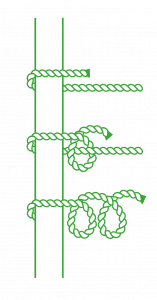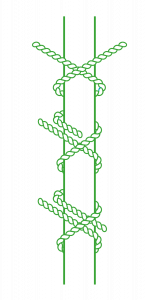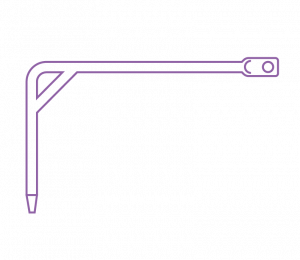Knots and Anchoring
How to tie Knots
There are three basic knots which are suitable for nearly every purpose on your boat.
Round Turn and Two Half Hitches

A good knot for tying up to mooring rings or posts. wrap the rope as many times as needed around the post to hold the boat, pass the free end of the rope under the standing rope (attached to the boat) and pass it through the loop you just created. Pull it tight to create a half hitch. Pass the free end of the rope under the standing rope and pass it through the loop you just created to give a second half hitch. Pull it tight.
Bowline

Used for making a loop in the end of a rope or tying up to a ring.
If tying up to a ring, Form a small loop in the rope in your hand then pass the free end of the rope through the ring. Bring the free end up and pass it through the loop you created (from the underside). Wrap the rope under the standing line and back down through the same loop. Tighten the knot by pulling on free end while holding standing line
Clove Hitch

Used for tying up to a post. Wrap the free end of the rope around the post, cross it over itself and around the post again. Pass the free end of the rope under the last wrap.
How to fix mooring Ropes
Where there are no mooring rings or posts you can use the L-shaped rhond anchors to attach to the mooring lines to banks or verges. Make sure that your ropes are not crossing any footpaths.

Anchoring with a Mud Weight
The mud weight allows you to moor in sheltered tide free water, e.g. Salhouse and Ranworth Broads. When doing this, remember that the boat will swing around the mud weight, as will any other boats with mud weights, so do not choose a place too near other boats or obstructing channels. Do not be afraid to let out a generous amount of rope which allows the mud weight to ‘set’ and prevent drifting. Do not moor up for the night in this way if strong winds are forecast – as you may drift as your mud weight is dragged along with you.
Head up into the wind in the desired place, and bring the boat to a standstill. Make sure the weight is secured by its rope and the rope is attached to the deck cleat/ring at the other end, and then gently lower it into the water so that it does not get stuck in the river bed.
If, when leaving a mooring the mud weight is difficult to lift, pull the rope as tight as possible, secure it to the cleat and, under power, move the boat slowly astern for a short distance. This will free the weight from the mud.
Put the engine into neutral and raise the mud weight. Rinse off the surplus mud by swinging the weight to and fro in the water before stowing it carefully on deck.
Are you looking for a Norfolk Broads boating holiday? If so, have a look at our entire fleet of hire cruisers.